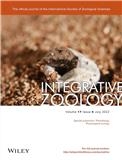| 投稿方式:官网投稿 |
- 栏目频次
- 单位占比
-
热词

低频栏目
-
更多
期刊简介
- 《整合动物学(英文版)》(IntegrativeZoology)(双月刊),创刊于2006年,是由中国科学院动物研究所和国际动物学会主办,并与国际出版商Wiley-Blackwell合作出版的动物学学术性英文期刊。刊物面向动物学工作者,旨在鼓励使用多学科、多层次的研究方法和理论,从不同角度、不同层面揭示和阐述宏观动物学规律,推动学科交叉和融合,发展整合动物学的理论和方法,为生物多样性保护、生物灾害控制和生物资源可持续利用,提供科学依据和学术交流沟通的国际平台。IntegrativeZoology是国内第一份以英文创办的动物学刊物,于2006年创刊,2010年被SCI收录。杂志涉及进化和系统分类、动物地理、行为和社会性、发育和生殖生育学、动物生态、功能形态学、比较免疫学、古生物学和进化、系统发生学和系统发生生物地理学、基因组信息学和进化、神经生物学和行为、生理和行为、遗传和行为、生理和生态、分子生态学、信息技术和生态学、数学生态学、植物-动物相互关系、生物入侵、生物多样性和保护、动物疾病、可持续发展和生物伦理学等专题。
-
基本信息
- 期刊名称:整合动物学(英文版)(Integrative Zoology)
- 主管单位:中国科学院
- 主办单位:中国科学院动物研究所、国际动物学会
- 国内刊号:CN 11-6012/Q
- 国际刊号:ISSN 1749-4877;EISSN1749-4869
-
- 出刊日期:
- 期刊定价:
-
- 邮发代码:
-
- 所在省区:北京
- 邮政编码:
- 联系地址:
-
投稿信息
-
- 学科分类:生物科学
- 版面费用:待核实
-
- 字数要求:12000-34000
- 查重要求:-
-
- 复合因子:0
- 综合因子:0
-
- 审 稿 费:待核实
- 稿费:待核实
- 本刊可发:
- 特殊属性:第一批认定学术期刊
-
联系方式
- 投稿网址:https://mc03.manuscriptcentral.com/inz
- 官网网址:
- 电话传真:010-64807295
- 电子邮箱:inz@ioz.ac.cn(官网邮箱)
- 微信公众号:

